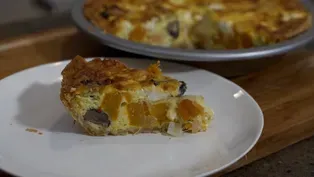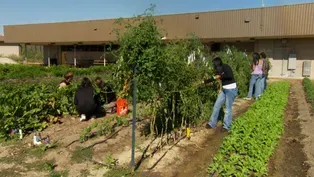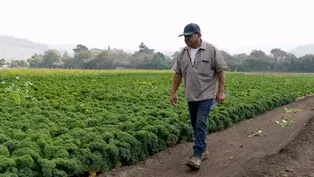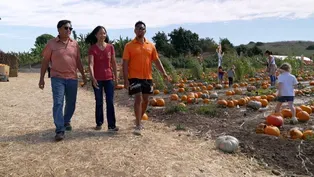
Growing Perennials – Harvesting Health
Clip: 8/9/2024 | 4m 6sVideo has Closed Captions
Explore the nutritional benefits of berries with our health expert.
Dive deeper into the nutritional and health benefits of perennial fruits and vegetables with Harvesting Health host Dr. Daphne Miller.
Problems with Closed Captions? Closed Captioning Feedback
Problems with Closed Captions? Closed Captioning Feedback
America's Heartland is presented by your local public television station.
Funding for America’s Heartland is provided by US Soy, Sustainable Agriculture Research and Education, Rural Development Partners, and a Specialty Crop Grant from the California Department of Food and Agriculture.

Growing Perennials – Harvesting Health
Clip: 8/9/2024 | 4m 6sVideo has Closed Captions
Dive deeper into the nutritional and health benefits of perennial fruits and vegetables with Harvesting Health host Dr. Daphne Miller.
Problems with Closed Captions? Closed Captioning Feedback
How to Watch America's Heartland
America's Heartland is available to stream on pbs.org and the free PBS App, available on iPhone, Apple TV, Android TV, Android smartphones, Amazon Fire TV, Amazon Fire Tablet, Roku, Samsung Smart TV, and Vizio.
Providing Support for PBS.org
Learn Moreabout PBS online sponsorship[♪♪♪♪♪] Daphne: So here we are at R&R Herbs with farmer and owner Jose Ramirez.
Jose, tell me, how many kinds of plants are you growing here?
Jose: It's blackberries, strawberries, raspberries and olallieberries and rosemary.
Daphne: That sounds like a lot of perennial plants.
Why do you like those plants?
Because you don't have to plant it every year.
Daphne: So you plant your Blackberries, and then how many years does it take before they really are producing at scale for you?
Jose: Blackberries produce the same year.
olallieberries take two years.
Daphne: And how about rosemary?
Jose: Rosemary.
It takes probably a couple of years or more before you have a good, you know, full production.
And we have plant has been in the ground for 50 years.
Daphne: Wow.
Jose: Yes.
And its still producing.
Daphne: And that whole time, it's got its roots in the soil and it's protecting the soil.
Jose: Oh yeah.
Oh yeah.
Daphne: It turns out that growing perennial crops is great for the soil.
These roots also help the plant access, water and minerals deep in the soil.
So that that plant requires less fertilizer and less water.
Because these plants are not uprooted, there is less tilling a farm practice which can harm soil microbes.
Perennial crops block out weeds, so there's less of a need for herbicides.
Perennial crops are also great homes for birds, butterflies and other pollinators, which help all the plants on the farm do better and lower the need for herbicides.
The fruit that grows on perennial plants.
Because these plants tend to be hardier.
The fruit is so good for you.
So strawberries, olallieberries, raspberries, blackberries are incredibly rich in phytonutrients.
Those chemical compounds that help our bodies fight cancer and even decrease our risk of diabetes and heart disease.
While the roots are promoting healthy bugs in the soil, the berries are doing the same in our gut by promoting a healthy microbiome.
One cup of berries offers about one third of our daily fiber needs.
I like to have mine on a salad or with a scoop of plain Greek yogurt and some chopped almonds or walnuts as garnish.
Rosemary is great with roast chicken and squash and potatoes and rosemary.
Essential oil rubbed on painful joints will help alleviate pain and inflammation.
Having a little bit of rosemary extract can help with your digestion.
It can also calm you or soothe your nerves just to smell rosemary.
So it's also used as an aroma therapy.
So it has a lot of more medicinal purposes as well.
Given all the ways that perennial crops impact soil health and our health.
We want to see more of them.
Perennials cover most of the earth, but make up only 13% of our cropland.
Fruit and nut trees and berry bushes are among the most common types of perennial crops.
But what about perennial vegetables?
Some in this region include asparagus and artichokes.
And in the Midwest, farmers are beginning to experiment with perennial wheat called Kernza, which is a cross between a wild wheat grass and your typical annual wheat.
It has twice as much protein and fiber as your standard wheat and a lot more disease fighting phytonutrients.
Perennial plants that have permanent roots in the ground are a win-win win for the farmer and the soil and eaters like us.
Autumn Vegetable Quiche – Farm to Fork with Sharon Profis
Video has Closed Captions
Clip: 8/9/2024 | 5m 41s | Find out how to cook an autumn vegetable quiche with mushrooms and leeks. (5m 41s)
Connecting and Feeding the Community
Video has Closed Captions
Clip: 8/9/2024 | 3m 20s | Discover how an urban school in the middle of a food desert built its own farm. (3m 20s)
Video has Closed Captions
Clip: 8/9/2024 | 4m 18s | A former farm laborer starts his own farm selling berries and rosemary. (4m 18s)
Video has Closed Captions
Clip: 8/9/2024 | 5m 50s | Visit a pumpkin patch that attracts tens of thousands of people a year. (5m 50s)
Providing Support for PBS.org
Learn Moreabout PBS online sponsorshipSupport for PBS provided by:
America's Heartland is presented by your local public television station.
Funding for America’s Heartland is provided by US Soy, Sustainable Agriculture Research and Education, Rural Development Partners, and a Specialty Crop Grant from the California Department of Food and Agriculture.















